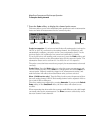
4-4
MegaZoom Concepts and Oscilloscope Operation
Deep Memory
Deep Memory
The primary advantage of a deep-memory oscilloscope is sustained sample rate,
allowing you to capture at the maximum sample rate and still capture a long
time window. For example, you may want to capture a fast digital event, such
as an interrupt line being asserted, while being able to look far out in time to
see when the line was de-asserted. This may require a fast sample rate to
examine the signal fidelity of the interrupt edge, and also long-time capture to
determine how long the interrupt line was asserted.
Another advantage is the ability to capture relatively longer periods of time or
slow time-per-division settings at an adequate sample rate. This allows you to
capture a long event, such as an oscillator starting up, or two events separated
by a long time, such that you can see the entire time frame of interest. To see
the event, the oscilloscope must have captured the information at a fast enough
sample rate so that you can see the interesting details.
Thus there are two major benefits of deep memory. First, long time spans can
be captured and then zoomed-in on for detailed analysis. Second, the deep
memory is displayed to the high-definition display with 32 levels of intensity for
more insight into the signal. This is particularly of value when dealing with
mixed analog and digital designs where slow analog events require long time
spans and fast digital control signals require the ability to maintain the sample
rate so interactions may be viewed in detail.
Memory depth values
54620-series 2 MB/ analog channel, 4MB max with single analog channel in Single mode.
8 MB/digital channel single pod, 4 MB/digital channel with 2 pods in use.
54640-series 4 MB/ analog channel, 8MB max with single analog channel in Single mode.
4 MB/digital channel single pod, 4 MB/digital channel with 2 pods in use.


















